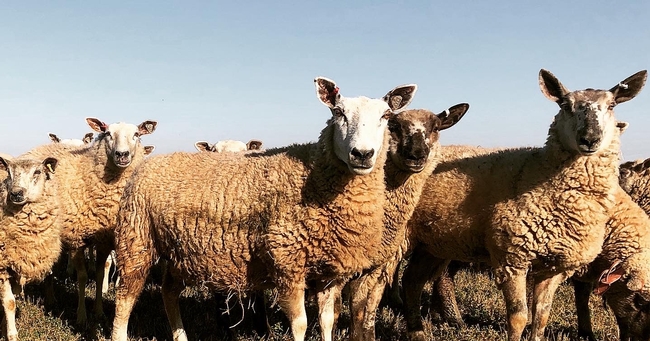Note: A version of this article originally appeared in the July 2020 edition of my New Foothill Rancher newsletter.
When my family started raising sheep commercially, we assumed that selling meat directly to consumers would be more profitable (especially at our small scale) than selling live animals. As we went through the logistics of getting animals to our processor, deciding what cuts we thought we could sell, determining our product pricing structure, picking up meat, getting it stored, and then getting it sold, we realized that meat marketing was far more complicated that hauling a load of lambs to the auction. We also got a crash course in the difference between gross profit and net profit.
Value-added marketing is a buzzword in local food system conversations – after all, who wouldn't want to add value to the crops or livestock they produce. Since the disruptions to our food system from COVID-19 have become obvious, producers and consumers alike have a renewed interest in selling (and buying) locally-produced meat. But as a producer, how do we know if we're actually adding value if we're selling meat rather than live animals? From an economic analysis perspective, we have to look at the meat business separately from the livestock production business. In other words, the meat business has to “buy” the live animal from the livestock business. How do we go about this kind of analysis?
In our own business, I started by using the market price for finished lambs (as published in weekly market reports from the closest livestock auctions) as the “purchase” price of lambs for the meat business. If a 100-pound lamb was worth $1.80 per pound at Escalon, my meat business would need to pay my livestock business $180 to buy that lamb, less what I would have paid in commission, yardage, and transportation. Let's value that 100-pound lamb at $160.
In economic analysis terms, the purchase of the lamb was a variable (or direct) expense for the meat business. Other direct expenses included harvest and cut-and-wrap fees (which are typically charged by the head or by the pound). Overhead costs – those expenses that are incurred regardless of the number of animals being processed, included transportation to and from the processor, storage, marketing expenses, and labor.
On the revenue side, I needed to know how much retail product I'd get from that 100-pound lamb. This is different than hot carcass (or hanging) weight – this is how much product actually goes into a package. We found that we typically got a 30-33 percent retail yield – in other words, the 100-pound lamb gave us 30-33 pounds of meat we could sell to our customers. We also needed to know the relative yield by cut – after all, folks will pay more for a rack of lamb than they will for stew meat. From this, we could calculate an average retail price per pound – for us, this came out to about $11 per pound of retail product. At 33 pounds of salable product, that lamb was now worth $363.
Let's look a bit closer at that $160 lamb:
|
Gross Revenue |
Amount |
|
Meat Sales (33 lbs at $12/lb) |
$363 |
|
Total Gross Revenue |
$363 |
|
|
|
|
Direct Expenses |
|
|
Lamb purchase |
$160 |
|
Slaughter/Cut-and-Wrap (per head) |
$145 |
|
Total Direct Expenses |
$305 |
|
Gross Margin |
$58 |
|
|
|
|
Overhead Expenses |
|
|
Transportation (live animal – 130 miles @ $0.57/mile) |
$74 |
|
Transportation (product – 130 miles @ $0.57/mile) |
$74 |
|
Storage (monthly locker fee) |
$125 |
|
Marketing (farmers market fee) |
$50 |
|
Labor (10 hours @ $15/hour) |
$150 |
|
Total Overhead Expenses |
$473 |
|
Net Profit (Loss) |
($415) |
Yikes – “adding” value to a single lamb would create a loss of $415! Maybe we should look at scaling up (so we can spread our overhead expenses over more units). I can take 20 finished lambs in my trailer – let's look at the numbers for 20!
|
Gross Revenue |
Amount |
|
Meat Sales (33 lbs at $12/lb) – 20 lambs |
$7,260 |
|
Total Gross Revenue |
$7,260 |
|
|
|
|
Direct Expenses |
|
|
Lamb purchase |
$3,200 |
|
Slaughter/Cut-and-Wrap (per head) |
$2,900 |
|
Total Direct Expenses |
$6,100 |
|
Gross Margin |
$1,160 |
|
|
|
|
Overhead Expenses |
|
|
Transportation (live animal – 130 miles @ $0.57/mile) |
$74 |
|
Transportation (product – 130 miles @ $0.57/mile) |
$74 |
|
Storage (monthly locker fee) |
$125 |
|
Marketing (farmers market fee – 5 weeks to sell 20 head) |
$200 |
|
Labor (10 hours @ $15/hour) |
$150 |
|
Total Overhead |
$623 |
|
|
|
|
Net Profit (Loss) |
$537 ($26.85/head) |
This time, we made a profit! All of that extra work added a whopping $26.85 per head to the value of our lambs! And this doesn't account for the time value of money – when I sell at the auction, I have a check within a week. When I sell meat, the cash flows in as I'm able to sell product – it may take a month or more.
Obviously, these numbers are sensitive to the current market price, the distance to your processor, and processing fees. In a depressed live market (like we're currently facing), marketing meat may add more value. And it's a complicated question - I found selling meat to my community to be rewarding in non-monetary ways. But non-monetary income didn't pay the bills, unfortunately. The key takeaway here is that it's important to do the analysis.
If you'd like to walk through a more thorough analysis of your own business, contact me at (530) 889-7385 or dmacon@ucanr.edu.

